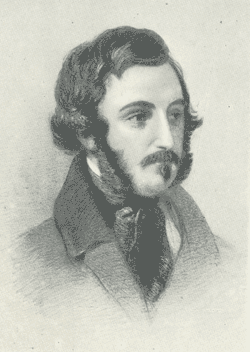Colonel Philip Meadows Taylor, Amateur
(b. 1808, d. 1876)
Amateur
From A Dictionary of Irish Artists 1913

Philip Meadows Taylor, Hon. R.H.A. Lithograph, by his brother, Weld Taylor.
Was born in Liverpool on 25th September, 1808. His father, Philip Meadows Taylor, a merchant, was son of the Rev. Philip Taylor of Old Court, Harold's Cross, Co. Dublin, who was grandson of John Taylor of Norwich, the hymn-writer. His mother was a daughter of Bertram Mitford, of Mitford Castle, Northumberland. Being delicate as a child he was sent to Ireland to his grandfather and passed some of his early years at Harold's Cross. His father having been unsuccessful in business, became manager to a brewery in James' Street, Dublin. At the age of 15 he was sent to India, but, finding on his arrival that the business concern in which he was to be placed was in an unsatisfactory state he accepted an offer of a commission in the Nizam's service in November, 1824. For thirty-six years he did important work in India. As Resident at Shorapore he administered the affairs of that state with conspicuous success, and afterwards governed the five Berar States. At the outbreak of the Mutiny he was despatched to North Berar, where, without any troops and solely by his tact and moral strength, he was able to keep perfect order in the country, and render important services to the Government. In 1858 he was again at Shorapore as Commissioner. His health breaking down he returned to Europe in 1860, and took up his residence at Old Court, Harold's Cross, near Dublin, where he spent the rest of his life. In 1869 he was made a Companion of the Star of India.
Taylor was a man of varied accomplishments. In 1839 he published his first book "The Confessions of a Thug," and now in his retirement he resumed his pen, and wrote a series of novels of Indian life in which he showed the most intimate acquaintance with native character and habits of thought. He also contributed the text for some illustrated works on India, and wrote a "Student's Manual of the History of India," published in 1870. During his life in the East, and afterwards in Ireland, he occupied himself at intervals in drawing and painting. In 1840 he sent two portraits to the Royal Hibernian Academy, and was an occasional exhibitor there afterwards of portraits and Indian subjects. He was made an Honorary Member of the Academy in 1868. In 1875 his sight failed, and he was advised to seek a change. His thoughts turned to India, and he determined to re-visit it. On his way home he stayed at Mentone, and there died on the 13th May, 1876.
His brother, WELD TAYLOR, a man of some versatility of talent, but unsettled and eccentric, essayed art in various forms—drawing, lithography, wood-carving, etc. He exhibited drawings in the Royal Hibernian Academy in 1840 and 1843, and also, about the same period, at the Society of British Artists. He published a number of lithographs. Among them was a series of twenty "Sketches in the Deccan" published in 1838, and a "Portrait of Miss Macmahon," after a miniature by Samuel Lover.
« John Mckinley Taylor | Contents and Search | William Benjamin Sarsfield Taylor »
